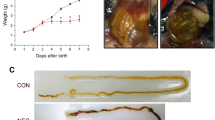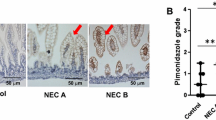Abstract
Purpose
The rat gavage model is used to explore the pathogenesis and treatment of necrotizing enterocolitis (NEC). Although intestinal histological damage is seen in this model, intestinal perforation is rarely observed. Whether organ failure occurs in this model is largely unknown. We hypothesised that increased intestinal permeability leads to organ failure in experimental NEC.
Methods
NEC was induced in neonatal rats by gavage feeding of hypertonic formula plus exposure to hypoxia plus oral lipopolysaccharide (4 mg/kg per day daily). Breast-fed rats were used for comparison. At 92 h, lactulose (3 mg) and mannitol (2 mg) were administered orally in 0.1 ml water. Four hours later, rats were killed and blood samples collected. Lactulose and mannitol were measured by gas chromatography–mass spectrometry and lactulose/mannitol ratio calculated as index of intestinal permeability. Plasma cardiac troponin-I was measured by ELISA as a marker of cardiac damage and plasma creatinine measured spectrophotometrically as a marker of renal failure.
Results
Experimental NEC induced an increase in intestinal permeability (P = 0.0002). This was associated with cardiac damage (P < 0.0001), and renal failure (P = 0.004).
Conclusion
Intestinal permeability is increased in experimental NEC in association with increased cardiac damage. Rat mortality may be due to cardiac failure secondary to an inflammatory response caused by increased intestinal permeability.




Similar content being viewed by others
References
Sonntag J, Wagner MH, Waldschmidt J, Wit J, Obladen M (1998) Multisystem organ failure and capillary leak syndrome in severe necrotizing enterocolitis of very low birth weight infants. J Pediatr Surg 33:481–484
Morecroft JA, Spitz L, Hamilton PA, Holmes SJK (1994) Necrotizing enterocolitis: multisystem organ failure of the newborn. Acta Paediatr 83:21–23
Smith SD, Tagge EP, Hannakan C, Rowe MI (1991) Characterization of neonatal multisystem organ failure in the surgical newborn. J Pediatr Surg 26:494–499
Petrosyan M, Guner YS, Williams M, Grishin A, Ford HR (2009) Current concepts regarding the pathogenesis of necrotizing enterocolitis. Pediatr Surg Int 25:309–318
Barlow B, Santulli TV, Heird WC, Pitt J, Blanc WA, Schullinger JN (1974) An experimental study of acute neonatal enterocolitis: the importance of breast milk. J Pediatr Surg 9:587–595
Sodhi C, Richardson W, Gribar S, Hackam DJ (2008) The development of animal models for the study of necrotizing enterocolitis. Dis Model Mech 1:94–98
Gribar SC, Sodhi CP, Richardson WM, Anand RJ, Gittes GK, Branca MF, Jakub A, Shi XH, Shah S, Ozolek JA, Hackam DJ (2009) Reciprocal expression and signaling of TLR4 and TLR9 in the pathogenesis and treatment of necrotizing enterocolitis. J Immunol 182:636–646
Halpern MD, Holubec H, Dominguez JA, Meza YG, Williams CS, Ruth MC, McCuskey RS, Dvorak B (2003) Hepatic inflammatory mediators contribute to intestinal damage in necrotizing enterocolitis. Am J Physiol Gastrointest Liver Physiol 284:G695–G702
Zani A, Eaton S, Leon FF, Malerba A, Hall NJ, De Coppi P, Smith VV, Pierro A (2008) Captopril reduces the severity of bowel damage in a neonatal rat model of necrotizing enterocolitis. J Pediatr Surg 43:308–314
Zani A, Cordischi L, Cananzi M, De Coppi P, Smith VV, Eaton S, Pierro A (2008) Assessment of a neonatal rat model of necrotizing enterocolitis. Eur J Pediatr Surg 18:423–426
Shippee RL, Johnson AA, Cioffi WG, Lasko J, Levoyer TE, Jordan BS (1992) Simultaneous determination of lactulose and mannitol in urine of burn patients by gas-liquid-chromatography. Clin Chem 38:343–345
Buddington RK, Bering SB, Thymann T, Sangild PT (2008) Aldohexose malabsorption in preterm pigs is directly related to the severity of necrotizing enterocolitis. Pediatr Res 63:382–387
Langer JC, Sohal SS, Riddell RH (1993) Mucosal permeability to 51Cr EDTA following subclinical intestinal ischemia–reperfusion injury in the weanling rat. J Pediatr Surg 28:601–605
Piena-Spoel M, Albers MJIJ, ten Kate J, Tibboel D (2001) Intestinal permeability in newborns with necrotizing enterocolitis and controls: does the sugar absorption test provide guidelines for the time to (re-)introduce enteral nutrition? J Pediatr Surg 36:587–592
Horton JW, White DJ (1991) Cardiac contractile injury after intestinal ischemia–reperfusion. Am J Physiol 261:H1164–H1170
Stefanutti G, Pierro A, Parkinson EJ, Smith VV, Eaton S (2008) Moderate hypothermia as a rescue therapy against intestinal ischemia and reperfusion injury in the rat. Crit Care Med 36:1564–1572
O’Brien PJ, Smith DEC, Knechtel TJ, Marchak MA, Pruimboom-Brees I, Brees DJ, Spratt DP, Archer FJ, Butler P, Potter AN, Provost JP, Richard J, Snyder PA, Reagan WJ (2006) Cardiac troponin I is a sensitive, specific biomarker of cardiac injury in laboratory animals. Lab Anim 40:153–171
Jaffé M (1886) Uber den niederschag, welchen pikrinsaure in normalem harn erzeugt und uber eine neue reaktion des kreatinins. Z Physiol Chem 10:391–400
Keppler A, Gretz N, Schmidt R, Kloetzer HM, Groene HJ, Lelongt B, Meyer M, Sadick M, Pill J (2006) Plasma creatinine determination in mice and rats: an enzymatic method compares favorably with a high-performance liquid chromatography assay. Kidney Int 71:74–78
Lanoue JL, Turnage RH, Kadesky KM, Guice KS, Oldman KT, Myers SI (1996) The effect of intestinal reperfusion on renal function and perfusion. J Surg Res 64:19–25
Acknowledgments
The study was partly supported by a grant from the Mittal Research Fund, London, UK. Mara Cananzi has been supported by Città della Speranza, ONLUS, Vicenza, Italy.
Author information
Authors and Affiliations
Corresponding author
Rights and permissions
About this article
Cite this article
Zani, A., Ghionzoli, M., Lauriti, G. et al. Does intestinal permeability lead to organ failure in experimental necrotizing enterocolitis?. Pediatr Surg Int 26, 85–89 (2010). https://doi.org/10.1007/s00383-009-2507-7
Published:
Issue Date:
DOI: https://doi.org/10.1007/s00383-009-2507-7




